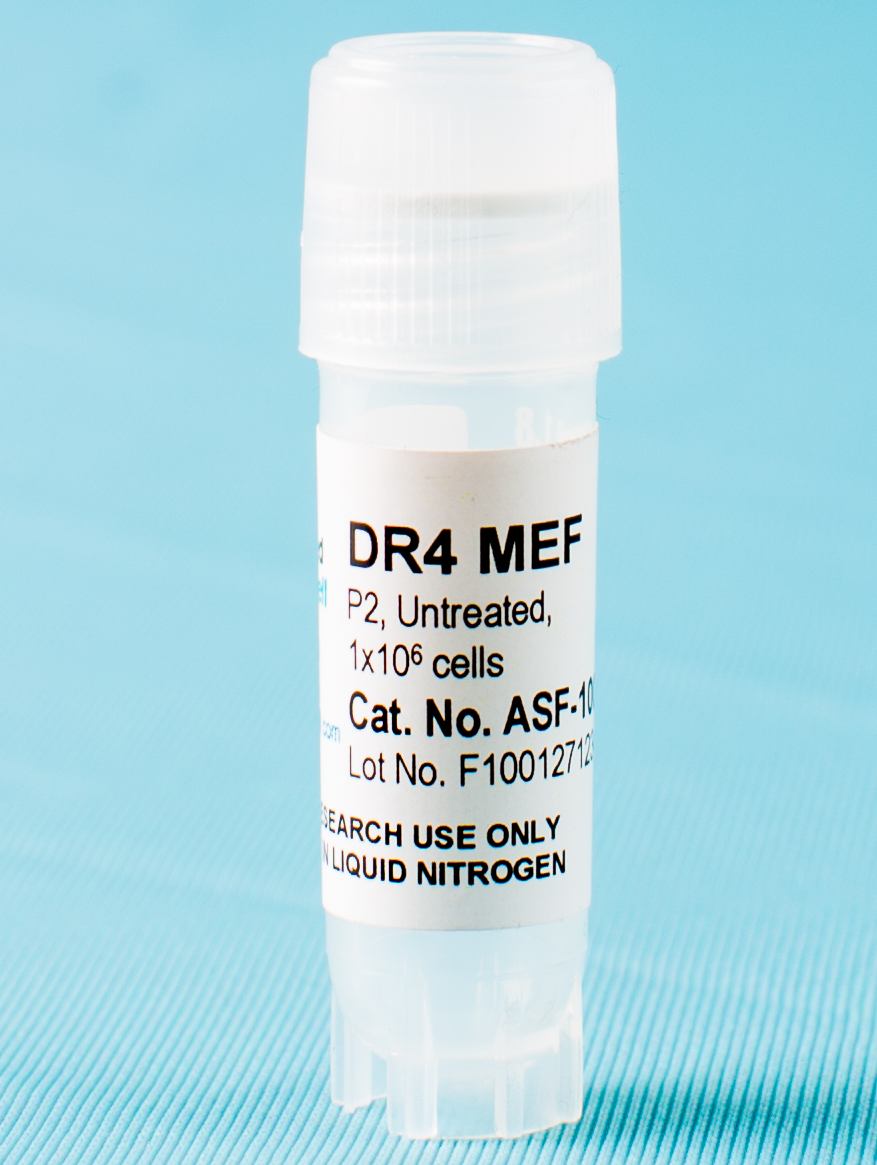Newsletter
DR4 MEF Feeder Cells
Derived from DR4 mouse embryos and are resistant to Neomycin, Hygromycin, Puromycin and 6-thioguanine.
MEF cells serve as feeder cells to support the growth of undifferentiated mouse or human embryonic stem Cells (ESCs) and induced pluripotent stem cells (iPSCs). MEF cells are isolated from mouse embryos and should be used at an early passage. Before use as feeder cells, MEF cells must be mitotically inactivated by γ-irradiation or mitomycin-C treatment.
DR4 MEF feeder cells are are derived from 13.5 day old mouse embryos that are genetically engineered to contain resistance genes to neomycin, hygromycin, puromycin and 6-thioguanin and are optimized for the culture of ES/iPS cells under drug selection.
All MEF cells are manufactured in the US and have an average viability of 95% after thawing. We offer both untreated cells for further expansion and treated cells that can be directly used as a feeder layer.
Also be sure to see our CF1 MEF Feeder Cells, Neo-resistant MEF Feeder Cells, and SNL 76/7 (STO Cell Line) MEF Feeder Cells.

Products and Services
Support Materials
Brochures/ Flyers:
Publications
DR4 MEF Feeder Cells
- Okubo, T., Hayashi, R., Shibata, S., Kudo, Y., Ishikawa, Y., Inoue, S., ... & Nishida, K. (2020). Generation and validation of a PITX2–EGFP reporter line of human induced pluripotent stem cells enables isolation of periocular mesenchymal cells. Journal of Biological Chemistry, 295(11), 3456-3465.
- Ruiz-Gutierrez, M., Bölükbaşı, Ö. V., Alexe, G., Kotini, A. G., Ballotti, K., Joyce, C. E., ... & Papapetrou, E. P. (2019). Therapeutic discovery for marrow failure with MDS predisposition using pluripotent stem cells. JCI insight, 4(12).
- Wagner, M., Yoshihara, M., Douagi, I., Damdimopoulos, A., Panula, S., Petropoulos, S., ... & Hovatta, O. (2020). Single-cell analysis of human ovarian cortex identifies distinct cell populations but no oogonial stem cells. Nature communications, 11(1), 1-15.
- Takahashi, M., & Yamazaki, S. (2019). Generation of a human induced pluripotent stem cell line, IMSUTi002-A-1, harboring the leukemia-specific fusion gene ETV6-RUNX1. Stem cell research, 40, 101546.
- Gruzdev, A., Scott, G. J., Hagler, T. B., & Ray, M. K. (2019). CRISPR/Cas9-Assisted Genome Editing in Murine Embryonic Stem Cells. In Mouse Models of Innate Immunity. Humana Press, New York, NY. 1690:1-21.
- Snijders, K. E., Cooper, J. D., Vallier, L., & Bertero, A. (2019). Conditional Gene Knockout in Human Cells with Inducible CRISPR/Cas9. In: Luo Y. (eds) CRISPR Gene Editing. Methods in Molecular Biology, Humana Press, New York, NY. 1961:185-209.
- Tan, C. E. H. (2018). Establishing a genetically engineered mouse ES cell line expressing an inducible Xist transgene along chromosome 19 (Doctoral dissertation).
- Fogarty, N. M., McCarthy, A., Snijders, K. E., Powell, B. E., Kubikova, N., Blakeley, P., ... & Maciulyte, V. (2017). Genome editing reveals a role for OCT4 in human embryogenesis. Nature, 550(7674), 67-73.
- Molokanova, O., Schönig, K., Weng, S. Y., Wang, X., Bros, M., Diken, M., ... & Eshkind, L. (2017). Inducible knockdown of procollagen I protects mice from liver fibrosis and leads to dysregulated matrix genes and attenuated inflammation. Matrix Biology. https://doi.org/10.1016/j.matbio.2017.11.002.
- Marttila, S. (2017). Establishment and characterisation of new human induced pluripotent stem cell lines and cardiomyocyte differentiation: a comparative view. Master’s Thesis, University of Tampere, May 2017.
- Honda, A., Kawano, Y., Izu, H., Choijookhuu, N., Honsho, K., Nakamura, T., ... & Sankai, T. (2017). Discrimination of stem cell status after subjecting cynomolgus monkey pluripotent stem cells to naive conversion. Scientific reports, 7, 45285.
- Friedel, T., Jung-Klawitter, S., Sebe, A., Schenk, F., Modlich, U., Ivics, Z., ... & Schneider, I. C. (2016). CD30 Receptor-Targeted Lentiviral Vectors for Human Induced Pluripotent Stem Cell-Specific Gene Modification. Stem cells and development, 25(9), 729-739.
- Ludwig, M., Kitzenberg, D., & Chick, W. S. (2015). Forward Genetic Approach to Uncover Stress Resistance Genes in Mice—A High-throughput Screen in ES Cells. Journal of visualized experiments: JoVE, (105).
- Neri, T., Muggeo, S., Paulis, M., Caldana, M. E., Crisafulli, L., Strina, D., ... & Scanziani, E. (2015). Targeted gene correction in osteopetrotic-induced pluripotent stem cells for the generation of functional Osteoclasts. Stem cell reports, 5(4), 558-568.
- Kraus, P., Sivakamasundari, V., Xing, X., & Lufkin, T. (2014). Generating mouse lines for lineage tracing and knockout studies. In Mouse Genetics(pp. 37-62). Humana Press, New York, NY.
- Zhu, F., Gamboa, M., Farruggio, A. P., Hippenmeyer, S., Tasic, B., Schüle, B., ... & Calos, M. P. (2013). DICE, an efficient system for iterative genomic editing in human pluripotent stem cells. Nucleic acids research, 42(5), e34-e34.
- Ivics, Z., Izsvák, Z., Chapman, K. M., & Hamra, F. K. (2011). Sleeping Beauty transposon mutagenesis of the rat genome in spermatogonial stem cells. Methods, 53(4), 356-365.
- Ivics, Z., Izsvák, Z., Medrano, G., Chapman, K. M., & Hamra, F. K. (2011). Sleeping Beauty transposon mutagenesis in rat spermatogonial stem cells. Nature protocols, 6(10), 1521.
- Pan, Y. (2011). Culturing of C57BL/6 Mouse Embryonic Stem (ES) Cell Line. Bio-protocol Bio101: e142. DOI: 10.21769/BioProtoc.142.
- Chapman, K. M., Saidley-Alsaadi, D., Syvyk, A. E., Shirley, J. R., Thompson, L. M., & Hamra, F. K. (2011). Rat spermatogonial stem cell-mediated gene transfer. In Advanced Protocols for Animal Transgenesis (pp. 237-266). Springer, Berlin, Heidelberg.
FAQs
Do the vials of DR4 MEFs (ASF-1015) contain cells from pooled embryos or is each vial from a single embryo?
How many passages can the DR4 MEFs, ASF-1001/ASF-1002 (Untreated P2) be passaged for?
How many vials of cells can you get from the untreated DR4 MEFs, ASF-1001/ASF-1002 (Untreated P2)?


-L1_L2.jpg)
